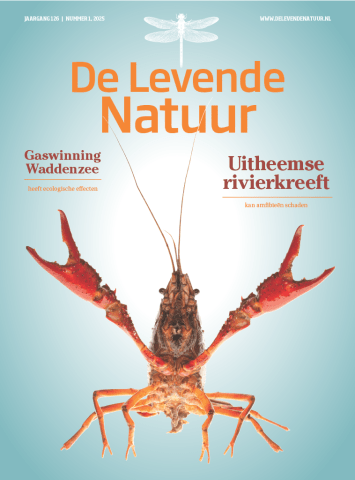De Levende Natuur nummer 1 van 2025 (English summary)
Afbeelding

Cover 1 2025
Non-native crayfish can harm amphibians
Invasive alien crayfish pose a major ecological threat in the Netherlands. However, their effects on native amphibian species are poorly known. Based on literature searches, surveys, and interviews with crayfish experts we combined different information sources to get a better understanding of the impact of alien crayfish on native amphibians. Literature sources mention effects of alien crayfish for 11 out of the 16 native amphibian species. Predation is the most frequently mentioned direct effect, while indirect effects, such as a reduction of aquatic plants, are mentioned once. All experts emphasize these indirect effects, while the majority also mention predation, especially of eggs and larvae, as a direct effect. Of the 37 returned surveys, 16 mention a reduction of amphibians, and 13 mention a complete disappearance of amphibians since the arrival of alien crayfish. These combined information sources strongly indicate a significant negative impact of invasive alien crayfish on native amphibians.
More herbs in impoverished grassland due to grazing
Grazing can have a positive effect on the development of semi-natural grasslands on sandy soil. In our trial, we found a higher number of species and a higher herb-cover in plots that were managed with cattle-grazing compared to mown plots. In both the mown and the grazed plots, specific species were found that were absent in the other treatment. Our results show therefore the added value of grazing by cattle, in its usefulness as a management tool. It can be used to strengthen the development of semi-natural grasslands that are located on relatively nutrient-poor sandy soils.
Variation in structure increases insect richness in inner dikes
In some cases, the insect-richness on Dutch inland polder dikes can be very high, even when surrounded by agricultural landscapes. Our study focused on the local factors that contribute to the diversity and abundance of some characteristic insect groups. During this four-year study we counted bees, butterflies and grasshoppers on 85 dikes and compared the results with a variety of factors in (a)biotics, vegetation and landscape setting. The strongest associations were found in factors which added to (micro-)habitat complexity. Furthermore, the relatively mobile solitary bees and bumblebees were more abundant on dikes in the proximity of large-scale nature reserves. Commonly considered factors, such as soil type, exposition or inclination of the slope, showed hardly any to no association with insect richness. Since dikes harbour valuable insect communities, changes in habitat management should be well considered. Mowing of dikes generally counteracts habitat complexity, so the implementation of (very) extensive grazing seems more effective for increasing insect abundance and diversity.

